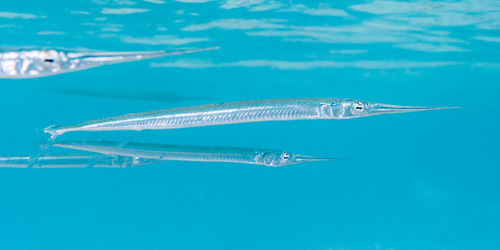
Keeltail Needlefish
The Atlantic Bluefin Tuna (Thunnus thynnus) is a highly migratory, large pelagic fish renowned for its size, speed, and commercial value. As a top predator in the marine ecosystem, it plays a crucial role. This species is warm-blooded, allowing it to thrive in a variety of temperatures.
2 5 years
Lifespan
30 - 50 cm
Length
Least Concern
Conservation Status
40 km/h
Swimming speed
Carnivorous
Diet
Local Migration
Migration
Appearance Overview
The Atlantic Bluefin Tuna is renowned for its large, streamlined body, built for speed and endurance.
Color
Dark metallic blue above, shimmering silvery-white below
Body shape
Torpedo-shaped, with a robust, fusiform body
Fins
Two dorsal fins, the first depressible; small, yellow finlets run from the second dorsal and anal fins to the tail.
Keel
Presence of a strong, lateral keel on the caudal peduncle
Length
Up to 13 feet (4 meters), commonly around 6.5 feet (2 meters)
Weight
Up to 2,000 lbs (900 kg), commonly around 550 lbs (250 kg)
Diet
Carnivorous, feeding on a variety of fish (such as herring, mackerel, and hake), squid, and crustaceans.
Feeding Behavior
Highly active predator, often hunting cooperatively in schools to herd and capture prey. They use their speed and agility to ambush and capture their food.
Social Behavior
Known to form schools, sometimes segregated by size. They are highly migratory, traveling long distances across oceans.
Commercial Relevance
Extremely high value, especially in sushi and sashimi markets, where its fatty, flavorful flesh is considered a delicacy. This demand drives high prices and intensive fishing.
Conservation measures
International fishing quotas, seasonal closures, minimum size limits, and efforts to reduce bycatch. Organizations like ICCAT manage stocks, but enforcement can be challenging.
Status
Endangered (Varies by stock; some populations are more depleted than others).
Threats
Overfishing (driven by high demand for sushi), bycatch in other fisheries, habitat degradation, and climate change affecting prey distribution and spawning grounds.
Habitat Distribution
Depth Range
Surface waters to depths of over 3,000 feet (1,000 meters), though they often stay in the upper layers of the water column.
Geographic Range
North Atlantic Ocean, Mediterranean Sea, and formerly the Black Sea.
Preferred Environment
Primarily pelagic, inhabiting temperate and subtropical waters. They undertake long migrations, often linked to spawning and feeding.
Reproduction and Life Cycle
Breeding Habits
Spawns in warm waters, primarily in the Mediterranean Sea and the Gulf of Mexico, with specific spawning grounds and times.
Development Stages
Eggs hatch into larvae, which develop rapidly in plankton-rich waters. Juveniles grow quickly, reaching considerable size within their first year.
Fecundity
Highly fecund; females can produce up to 30 million eggs per spawning season, releasing them into the water for external fertilization.
Maturity Age
Reaches sexual maturity at around 4-8 years of age, though this can vary depending on the population and environmental conditions.
Faqs about Keeltail Needlefish
How long do Atlantic Bluefin Tuna live?
Atlantic Bluefin Tuna can live up to 40 years, although this is becoming increasingly rare due to fishing pressure.
Where can I find Atlantic Bluefin Tuna?
They are found throughout the North Atlantic Ocean and its adjacent seas, including the Mediterranean Sea.
Are Atlantic Bluefin Tuna warm-blooded?
Yes, they are warm-blooded, possessing a specialized circulatory system that allows them to maintain a body temperature higher than the surrounding water.
How fast can Atlantic Bluefin Tuna swim?
They can reach speeds up to 43 mph (70 km/h) in short bursts, making them one of the fastest fish in the ocean.
How many eggs do they lay?
A female can release up to 30 million eggs per spawning season, though the survival rate of these eggs is very low.
Are Bluefin Tuna populations healthy?
No. Overfishing has significantly depleted their populations, and they are listed as endangered.
Copyright @ Nature Style Limited. All Rights Reserved.
 English
English